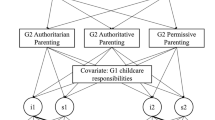Abstract
Although bidirectional parent and child influences have been incorporated in theoretical models pertaining to the development of internalizing and externalizing behaviors in youth, studies have historically focused on the socializing influence that parents have on their children. This has left several important research questions unanswered about the nature of bidirectional parent–child relations across development, including how these bidirectional effects are related to different types of child and adolescent psychopathology. The goal of this special section is to examine some longstanding issues regarding the nature of bidirectional parent–child effects across time using a diverse array of longitudinal datasets. The results from these studies emphasize the importance of considering bidirectional effects in developmental psychopathology research, particularly the often overlooked influence that children and adolescents have on their parents’ behavior and emotional well-being. Following these empirical articles, an expert in the field provides a scholarly commentary designed to outline the progress that has been made in understanding bidirectional parent–child effects across development as well as to propose fruitful areas for future research.
Similar content being viewed by others
References
Abidin, R. R. (1986). Parenting Stress Index (PSI) manual (2nd ed.). Charlottesville, VA: Pediatric Psychology.
Abidin, R. R. (1990). Parenting Stress Index Manual (3rd ed.). Charlottesville, VA: Pediatric Psychology Press.
Bell, R. Q. (1968). A reinterpretation of the direction of effects in studies of socialization. Psychological Review, 75, 81–95.
Bell, R. Q. (1980). Socialization findings re-examined. In R. Q. Bell, & L. B. Harper (Eds.) Child effects on adults (pp. 53–84). Lincoln, NE: University of Nebraska Press.
Bell, R. Q. (1981). Citation classic—a reinterpretation of the direction of effects in studies of socialization. Citation Classic/Social and Behavioral Sciences, 16, 18–18.
Bell, R. Q., & Harper, L. V. (1977). Child effects on adults. Hillsdale, NJ: Lawrence Erlbaum.
Belsky, J. (1984). The determinants of parenting: a process model. Child Development, 55, 83–96.
Belsky, J., & Vondra, J. (1989). Lessons from child abuse: the determinants of parenting. In D. Cicchetti, & V. Carlson (Eds.) Child maltreatment: theories and research on the causes and consequences of child abuse and neglect (pp. 153–202). Cambridge, England: Cambridge University Press.
Brestan, E. V., & Eyberg, S. M. (1998). Effective psychosocial treatments of conduct-disordered children and adolescents: 29 years, 82 studies, and 5,272 kids. Journal of Clinical Child Psychology, 27, 180–189.
Crouter, A. C., & Booth, A. (Eds.). (2003). Children’s influence on family dynamics: the neglected side of family relationships. Mahwah, NJ: Lawrence Erlbaum Associates.
Eddy, J. M., Leve, L. D., & Fagot, B. I. (2001). Coercive family processes: a replication and extension of Patterson’s coercion model. Aggressive Behavior, 27, 14–25.
Lytton, H. (1990). Child and parent effects in boys’ conduct disorder: a reinterpretation. Developmental Psychology, 26, 683–697.
Lytton, H. (2000). Toward a model of family-environmental and child-biological influences on development. Developmental Review, 20, 150–179.
Mischel, W. (1973). Toward a cognitive social learning conceptualization of personality. Psychological Review, 80, 252–283.
Pardini, D. A. (2008). Empirically supported treatments for conduct disorders in children and adolescents. In J. A. Trafton, & W. P. Gordon (Eds.) Best practices in the behavioral management of health from preconception to adolescence (pp. 290–321). Los Altos, CA: Institute for Brain Potential.
Patterson, G. R. (1982). Coercive family processes. Eugene, OR: Castalia.
Patterson, G. R. (1995). Coercion as a basis for early age of onset for arrest. In J. McCord (Ed.) Coercion and punishment in long-term perspectives (pp. 81–105). New York: Cambridge Press.
Patterson, G. R. (2002). The early development of coercive family process. In J. B. Reid, G. R. Patterson, & J. J. Snyder (Eds.) Antisocial behavior in children and adolescents: a developmental analysis and the Oregon model for intervention (pp. 25–44). Washington, DC: American Psychological Association.
Patterson, G. R., Dishion, T. J., & Bank, L. (1984). Family interaction: a process model of deviancy training. Aggressive Behavior, 10, 253–267.
Patterson, G. R., Reid, J. B., & Dishion, T. J. (1992). Antisocial boys. Eugene, OR: Castalia.
Pettit, G. S., & Lollis, S. (1997). Introduction to special issue: Reciprocity and bidirectionality in parent–child relationships: New approaches to the study of enduring issues. Journal of Social and Personal Relationships, 14, 435–440.
Plomin, R., DeFries, J. C., & Loehlin, J. C. (1977). Genotype–environment interaction and correlation in the analysis of human behavior. Psychological Bulletin, 84, 309–322.
Sameroff, A. (1975). Transactional models in early social relations. Human Development, 18, 65–79.
Scarr, S., & McCartney, K. (1983). How people make their own environments: a theory of genotype–environment effects. Child Development, 54, 424–435.
Shaw, D. S., & Bell, R. Q. (1993). Developmental theories of parental contributors to antisocial behavior. Journal of Abnormal Child Psychology, 21, 493–518.
Snyder, J., & Stoolmiller, M. (2002). Reinforcement and coercion mechanisms in the development of antisocial behaviour: the family. In J. B. Reid, G. R. Patterson, & J. J. Snyder (Eds.)Antisocial behavior in children and adolescents: a developmental analysis and the Oregon model for intervention (pp. 65–100). Washington, DC: American Psychological Association.
Author information
Authors and Affiliations
Corresponding author
Additional information
Preparation of this paper was supported by funding from the National Institute on Mental Health (1K01MH078039–01A1). Special thanks to John Lochman, Jeffrey Burke, Rebecca Stallings, Jamie Pardini, Sassy Pardini, and Slippy Pardini for their assistance on this project.
Rights and permissions
About this article
Cite this article
Pardini, D.A. Novel Insights into Longstanding Theories of Bidirectional Parent–Child Influences: Introduction to the Special Section. J Abnorm Child Psychol 36, 627–631 (2008). https://doi.org/10.1007/s10802-008-9231-y
Received:
Accepted:
Published:
Issue Date:
DOI: https://doi.org/10.1007/s10802-008-9231-y




